Life and career
Duban won the Prix de Rome in 1823, the most prestigious award of the École des Beaux-Arts. He was much influenced by his five-year stay in Italy, particularly his sense of color, influenced by the polychrome paintings of ancient Pompeii, newly uncovered Etruscan tombs, and the tradition of the great decorations painted in the Renaissance.
By far Duban's most visible work is the main building of the École, undertaken in 1830. The main building, the Palace of Studies, was designed with integral paintings and interior sculpture for artists' education. His redesign and alignment of the entire campus frames the main building from the entrance on Rue Bonaparte. With other expansions towards the Seine, this work was completed around 1861.
Duban was elected as member of the Academy of Fine Arts in 1854. Among his many students was Charles-Auguste Questel; he was the brother-in-law of fellow architect François Debret.

Eugène Emmanuel Viollet-le-Duc was a French architect and author, famous for his restoration of the most prominent medieval landmarks in France. His major restoration projects included Notre-Dame de Paris, the Basilica of Saint Denis, Mont Saint-Michel, Sainte-Chapelle, the medieval walls of the city of Carcassonne, and Roquetaillade castle in the Bordeaux region.
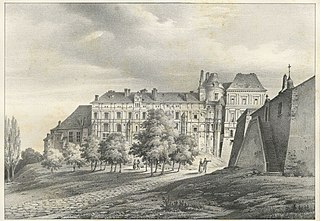
The Royal Château of Blois is a château located in the city center of Blois, Loir-et-Cher, in the Loire Valley, France. In addition to having been the residence of the Counts of Blois and some French Kings, Joan of Arc also went there by 1429 to be blessed by the Archbishop of Reims before departing with her army to drive against the English, who conquered Orléans the previous year.

The Château de Chaumont, officially Château de Chaumont-sur-Loire, is a castle (château) in Chaumont-sur-Loire, Centre-Val de Loire, France. The castle was founded in the 10th century by Odo I, Count of Blois. After Pierre d'Amboise rebelled against Louis XI, the king ordered the castle's destruction. Later in the 15th century Château de Chaumont was rebuilt by Charles I d'Amboise. Protected as a monument historique since 1840, the château was given into state ownership in 1938 and is now open to the public.
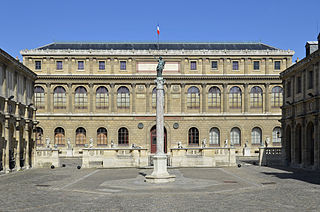
The Beaux-Arts de Paris, formally the École nationale supérieure des beaux-arts, is a French grande école whose primary mission is to provide high-level fine arts education and training. The art school, which is part of the Paris Sciences et Lettres University, is located on two sites: Saint-Germain-des-Prés in Paris, and Saint-Ouen.

Beaux-Arts architecture was the academic architectural style taught at the École des Beaux-Arts in Paris, particularly from the 1830s to the end of the 19th century. It drew upon the principles of French neoclassicism, but also incorporated Renaissance and Baroque elements, and used modern materials, such as iron and glass, and later, steel. It was an important style and enormous influence in Europe and the Americas through the end of the 19th century, and into the 20th, particularly for institutional and public buildings.

French art consists of the visual and plastic arts originating from the geographical area of France. Modern France was the main centre for the European art of the Upper Paleolithic, then left many megalithic monuments, and in the Iron Age many of the most impressive finds of early Celtic art. The Gallo-Roman period left a distinctive provincial style of sculpture, and the region around the modern Franco-German border led the empire in the mass production of finely decorated Ancient Roman pottery, which was exported to Italy and elsewhere on a large scale. With Merovingian art the story of French styles as a distinct and influential element in the wider development of the art of Christian Europe begins.

The Château de Gaillon is a French Renaissance castle located in Gaillon, Normandy region of France.

Taking its name from medieval troubadours, the Troubadour Style is a rather derisive term, in English usually applied to French historical painting of the early 19th century with idealised depictions of the Middle Ages and the Renaissance. In French it also refers to the equivalent architectural styles. It can be seen as an aspect of Romanticism and a reaction against Neoclassicism, which was coming to an end at the end of the Consulate, and became particularly associated with Josephine Bonaparte and Caroline Ferdinande Louise, duchesse de Berry. In architecture the style was an exuberant French equivalent to the Gothic Revival of the Germanic and Anglophone countries. The style related to contemporary developments in French literature, and music, but the term is usually restricted to painting and architecture.

Dampierre-en-Yvelines is a commune in the Yvelines department in the Île-de-France region in north-central France.
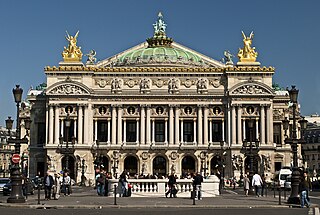
Second Empire style, also known as the Napoleon III style, is a highly eclectic style of architecture and decorative arts originating in the Second French Empire. It was characterized by elements of many different historical styles, and also made innovative use of modern materials, such as iron frameworks and glass skylights. It flourished during the reign of Emperor Napoleon III (1852–1870) and had an important influence on architecture and decoration in the rest of Europe and North America. Major examples of the style include the Opéra Garnier (1862–1871) in Paris by Charles Garnier, the Institut National d'Histoire de l'Art, the Church of Saint Augustine (1860–1871), and the Philadelphia City Hall (1871–1901). The architectural style was closely connected with Haussmann's renovation of Paris carried out during the Second Empire; the new buildings, such as the Opéra, were intended as the focal points of the new boulevards.

École des Beaux-Arts refers to a number of influential art schools in France. The term is associated with the Beaux-Arts style in architecture and city planning that thrived in France and other countries during the late nineteenth century and the first quarter of the twentieth century.
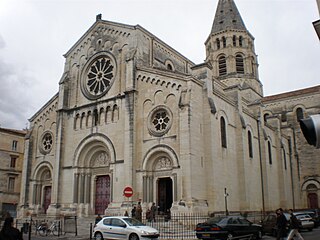
Charles-Auguste Questel was a French architect and teacher. As well as designing new buildings, his projects included the preservation of historical monuments. He worked on several historical monuments included in France's first list of such structures, the list of 1840.

François Debret was a 19th-century French architect and Freemason. He was one of a group of influential academic architects in the 1820s and 1830s that furthered the precepts of Percier and Fontaine, although little of his own work survives.

Antoine-Nicolas Louis Bailly was a French architect.

The Galerie d'Apollon is a large and iconic room of the Louvre Palace, on the first (upper) floor of a wing known as the Petite Galerie. Its current setup was first designed in the 1660s. It has been part of the Louvre Museum since the 1790s, was completed under the lead of Félix Duban in the mid-19th century, and has housed the museum's collection of the French Crown Jewels since 1887.
Jean-Charles-Léon Danjoy was a French architect who specialized in renovating historical buildings.
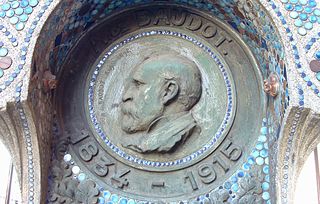
Joseph-Eugène-Anatole de Baudot was a French architect and a pioneer of reinforced-concrete construction. He was a prolific author, architect for diocesan buildings, architect for historical monuments, and a professor of architecture. He is known for the church of Saint-Jean-de-Montmartre in Paris, the first to be built using concrete reinforced with steel rods and wire mesh.

Jean-Baptiste-Antoine Lassus was a French architect who became an expert in restoration or recreation of medieval architecture. He was a strong believer in the early Gothic architecture style, which he thought as a true French and Christian tradition, and was opposed to the classical Graeco-Roman styles promoted by the academic establishment.
The style of architecture and design under King Louis Philippe I (1830–1848) was a more eclectic development of French neoclassicism, incorporating elements of neo-Gothic and other styles. It was the first French decorative style imposed not by royalty, but by the tastes of the growing French upper class. In painting, neoclassicism and romanticism contended to become the dominant style. In literature and music, France had a golden age, as the home of Frédéric Chopin, Franz Liszt, Victor Hugo, Honoré de Balzac, and other major poets and artists.

Stanislas-Louis Bernier was a French architect.

















